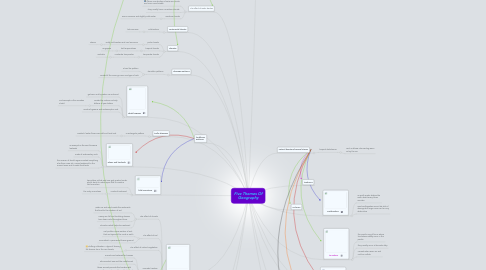
1. continental climate
1.1. cold winters
1.1.1. hot summers
2. The effect of water bodies
2.1. Places near bodies of water are cooler and more comfortable
2.2. They usually have a maritime climate
2.3. maritime climate
2.3.1. warm summers and slightly cold winter
3. climates
3.1. polar climate
3.1.1. really cold winters and cool summers
3.1.1.1. siberia
3.2. tropical climate
3.2.1. hot tempuratures
3.2.1.1. singapore
3.3. temperate climate
3.3.1. moderate tempurates
3.3.1.1. australia
4. trellis drainage
4.1. a rectangular pattern
4.1.1. created if water flows over soft and hard rock
5. drainage patterns
5.1. dendritic patterns
5.1.1. a tree like pattern
5.1.2. created if the rivers go over one type of rock
6. small landholders
6.1. mexico,south america,africa,and south asia
6.2. they grow food as a family , and then they barter it.
6.3. weather is harsh on the family so they may die cause of it.
6.3.1. and they are always close to poverty
7. shifting cultivators
7.1. they used machetes to clear out small jungles
7.2. they would grow corn and other things.
7.3. soil erosion is an issue when the rural population increases in the rain forest
8. landforms patterns
9. shield regions
9.1. get worn out by water ice and wind
9.2. created by volcanic activity billions of year before
9.2.1. and example is the canadian shield
9.3. made of igneous and metamorphic rock
10. plains and lowlands
10.1. an example is the saint laurence lowlands
10.2. made of sedimentary rock
10.3. the erosion of sheild regions ceated everything else then rivers etc. carried sediment to the ancient seas, and it made thick beds
11. fold mountains
11.1. two plates collide and one gets pushed under which starts to make layers fold to create a fold mountain.
11.2. made of sediment
11.2.1. the rocky mountains
12. Climate
12.1. The effect of moving air
12.1.1. Hot air floats and eventually creates rain
12.1.2. when air rises it cools down and it creates water droplets that make clouds
12.2. The effect of latitude
12.2.1. The warmest areas are closest to the equator
12.2.2. Less concentrated latitudes are near the south and North Pole
12.2.3. Antarctica is the coldest
12.3. The effect of mountains
12.3.1. Cooler at the peak
12.3.2. Usually has loads of precipitation
12.4. The effect of ocean currents
12.4.1. Effects coastal temperatures
12.4.2. Warm waters flow away and cold flow towards coastlines/equators
13. AGRICULTURE
13.1. The effect of climate
13.1.1. Water ice and wind create the sediments that lead to the creation of soil
13.1.2. Heavy rain fall and tumbling streams tear down rocks throughout time.
13.1.3. Climate is what helps to create soil
13.2. The effect of soil
13.2.1. Soil profile:a cross section of soil, that are layers of the crust in earth
13.2.2. Permafrost: a permanent frozen ground
13.3. The effect of natural vegatation
13.3.1. Shifting cultivation: a type of farming tht farmers do in the rain forest!!
13.4. nomadic herders
13.4.1. animals are bartered for luxuries
13.4.2. africa,central asia and the middle east
13.4.3. these animals provide the herders with many things such as milk,meat,hides and hair.
13.4.4. they survive on there abilitys that help animals.
13.5. commercial agriculture
13.5.1. grow crops etc. and sell it for a profit
13.6. organic food
13.6.1. foods grown without chemicals fertilizers etc.
13.7. subsistence agriculture
13.7.1. is when you only farm for the family
13.8. intensive farming
13.8.1. when you get food from small lands
13.9. extensive farming
13.9.1. a samml amount work on a big area
14. shield cone and composite cone
14.1. shield cone-a valcano made of only magma
14.2. composite cone-made of layers of magma and cinder.
15. natural disasters/tropical storms
15.1. tropical disturbance
15.1.1. cool air blows into swirling warm air by the sun
16. tsunami
16.1. begins in oceans
16.2. tsunamis ussually are occured of underground natural disasters such as earth quakes.
17. tornadoes
17.1. the pacific ring of fire is where tornadoes mostly occur in the pacific.
17.2. they mostly occur at tornado alley
17.3. caused when warm air and cold air collide.
18. hurricanes
18.1. originate from warm waters
18.1.1. Coast of Africa Pacific Ocean
